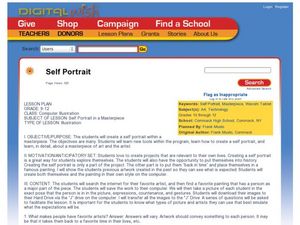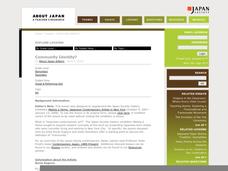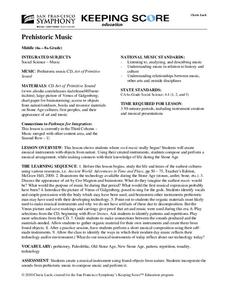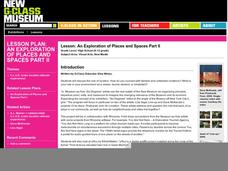National Mississippi River Museum & Aquarium
Sun Printing
Ozalid acid paper is sensitive to the light. It reacts by getting darker, and it's the same paper photographers use when they print their pictures. Here, kids get to use photo-sensitive paper to create sun prints to find out how useful...
Denver Art Museum
Lesson Plan: Symbols & Community
Sand mandalas are transitory art forms that are created by a group for the purpose of healing. Upper graders learn how Tibetan monks create these amazing works of art, and study symbolism and metaphor. Then pupils work together in a...
Denver Art Museum
Lesson: What are Words For?
Words are everywhere in our lives, and our culture shapes how we understand them. Examine the use of words and their impact on society by first examining a word-inspired art piece, and then by creating a thoughtful word-inspired collage....
Denver Art Museum
Lesson Plan: Stories of Home on My Home
Learners research the Lakota tribes, culture, art, and family life. They analyze an installation piece created by a Lakota Indian, and connect what they see to the concept of home. They engage in a discussion, creative writing activity,...
Curated OER
Lesson: Wish You Were Here...
The painting Arcadia features a lovely landscape depicting aspects of ancient Greek life. Little ones use their imagination to put themselves in the painting. After analyzing the details and artistic elements of the painting, they write...
Denver Art Museum
Lesson: That's Not Natural
Any time kids engage in a design project, they are building problem-solving skills, collaborative learning skills, and creative thinking skills. Upper graders take a nature walk to observe and sketch organic shapes and lines that they...
Denver Art Museum
Communicating with Symbols
Before kids analyze a Chinese dish filled with amazing images, they research the meanings of various plant and animal symbols. They use their research to decode the meaning of the expressive artwork on the dish and then use symbolism to...
Digital Wish
Illustration: Self Portrait in a Masterpiece
Technology and art combine in a creative lesson. Kids discuss portrait art and they search online and save a portrait created by one of their favorite artists. They have their picture taken exactly like their chosen portrait, then use...
Asian Art Museum
Community Identity?
To better understand the contemporary arts movement in Japan, learners engage in a guided discussion. They view several photograms by the artist Kunie Sugirua, then discuss the elements of art and techniques used to create each piece....
San Francisco Symphony
Music Reflects History
Exploring the baroque era can be exciting and fun when it's done thorugh the arts. Middle schoolers examine the music and art history of the baroque era through research. They use their findings and class notes to create an expository...
San Francisco Symphony
Prehistoric Music
What was music like during the Stone Age? Learners listen to a CD entitled, Art of Primitive Sound as they consider the culture of people in the Stone Age. They use objects found in nature to create instruments, and then perform a...
San Francisco Symphony
Admirable Armonica Admirers
What do Ben Franklin and Wolfgang Mozart have in common? Find out about the musical invention, the armonica or glassy-chord. Learners will read about how Ben Franklin invented this new instrument and how Wolfgang Mozart came to play it....
San Francisco Symphony
American Civil War Songs
Learners will compare and contrast two songs from the Civil War era, one from the North and one from the South. They'll write a comparative essay on their songs, and then compare their essays and songs with others in their small groups....
Philadelphia Museum of Art
Is There Art in Nature? What Is The Nature of Art?
It's always great to find cross-curricular lessons, especially when they integrate two very interesting topics. Learners will consider three paintings as they relate to both science and art. They'll discuss each piece and then respond to...
Santa Ana Unified School District
Frida Kahlo
Before one can understand the work of Frida Kahlo, one needs to understand her life. Provide learners with background information on Frida's life as a person and a painter. The slides then provide information regarding several of her...
Sargent Art
Metal Embossing Weathervanes
Metal work has been used for hundreds of years. Ninth graders get a chance to experience the artistry of metal embossing in this highly structured lesson. Each step is accented with a helpful image and related instruction. The end...
Sargent Art
Picasso and Beyond!
After reviewing the life and art of Pablo Picasso, learners set out to create abstract, cubist, relief portraits. They'll draw, color, paint, and cut out portraits just like the ones Picasso created. The lesson is extremely well written...
Sargent Art
Color Value Study
I love geometric art because it applies mathematical reasoning to an artistic endeavor. Creative kids use scale values to highlight their complex, repetitive, geometric designs. Symmetry, angles, and congruence are three concepts that...
Asian Art Museum
Defining "Home"
Open-ended dialogue and guiding questions lead children through a discussion about the relationship between physical objects and personal identity. They analyze the work of two contemporary Japanese artists who have use their mediums to...
BBC
Anne Bancroft Dies
High schoolers get together in groups to read and learn about the life of film actress Anne Bancroft. After a teacher-led presentation on her life, each of the groups must complete tasks described by the worksheets embedded in the plan....
New Class Museum
Lesson: An Exploration of Places and Spaces Part II
How does your location alter or impede your movement? An interesting question posed by two artists, who work to show the restrictions of people in various landscapes. Learners analyze both exhibitions, discuss location and movement, then...
New Class Museum
Lesson: Elizabeth Peyton: Portraits: Androgyny in Contemporary Culture
Portraiture, artistic expression, romanticism, and androgyny are discussed in a thought-provoking lesson. Upper graders first discuss and examine the history of portraiture and the elements common to the Romantic style. Then they turn...
New Class Museum
Lesson: Emory Douglas: Decoding Images and Vocabulary Activity
To better understand the work of Black Panther logo artist Emory Douglas, learners define literary devices. They define a series of words such as metaphor, simile, and assonance, then place an example of that device found in Emory...
New Class Museum
Lesson: French Revolution and Visual Language of Power
Take a look at the French Revolution and neo-classic art, then compare it to current social issues and contemporary art. Kids analyze several pieces painted by Jacques-Louis David in regard to style and subject then compare them to...

























